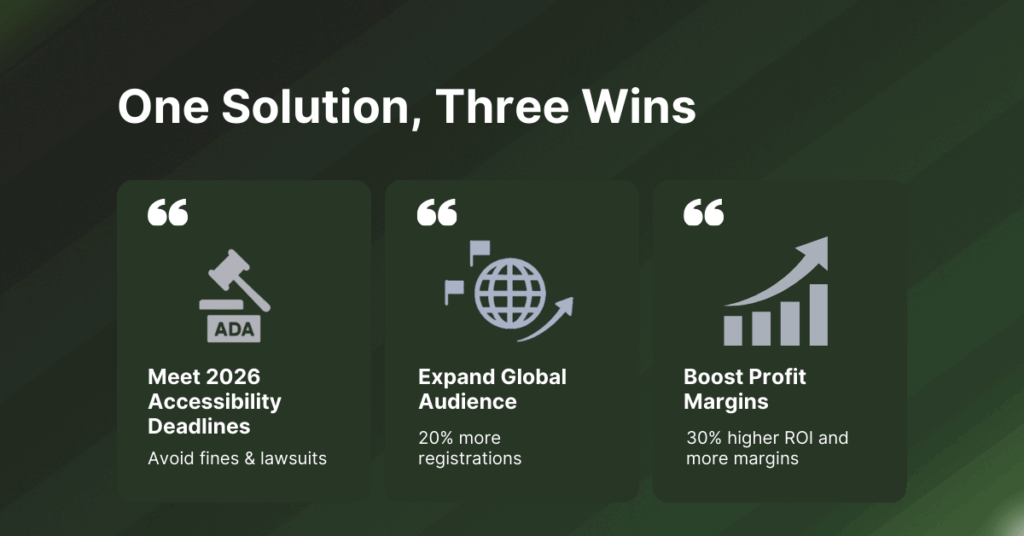Imagine your recent big event. A presenter delivers groundbreaking information, but 25% of your audience misses out on essential details. Some have hearing impairments. Others struggle with language. New federal regulations, however, require accessible events by 2026 and impose stiff penalties for non-compliance. Here’s the surprising reality: resolving these accessibility issues actually increases revenue.
The Perfect Storm: Legal Pressure Meets Business Opportunity
Event planners are confronted with a clash of influences. The Americans with Disabilities Act now mandates ADA compliant transcription for all public events by April 2026. Organizations with 50,000+ customers are required to comply by April 2026, those with fewer by April 2027. Offenses lead to lawsuits and federal charges.
At the same time, event demographics have changed radically. Now, 53% of event planners indicate that at least a quarter of participants are not native English speakers. Almost half of corporate events have six or more languages involved. This is not diversity, it’s lost business when those attendees cannot engage to their full capabilities.
That’s where it gets exciting. Multilingual transcription solutions address both issues with a single technology. You’re in compliance with the law while reaching previously inaccessible audiences. Events that employ these solutions see 20% more registered events and 30% increased profit margins. The same technology that keeps you in compliance also earns you money.

How Modern Translation Technology Actually Works
Forget what you thought you knew about conventional interpreting. Gone are the interpreter booths, rental headsets, and knotted cabling. Modern real-time translation platform technology operates via attendees’ smartphones.
This is how it works easily: Your speaker speaks as usual. AI speech translation services translate speech in real-time to text. The text shows up on attendees’ phones in the language of their preference, all within two seconds. Attendees simply scan a QR code, select their language from 40+ choices, and track along.
This pace counts. Conventional human interpreters fall 5-10 seconds behind speakers, resulting in confusion during Q&A sessions. Contemporary AI is kept in near-realtime synchrony, keeping listeners interested in the actual conversation rhythm.
The technology manages complexity that is beyond humans. Interpreters process one language at a time, whereas multilingual transcription solutions process unlimited languages in parallel. One presentation can reach listeners in English, Mandarin, Spanish, Arabic, and dozens of other languages, all from one system.
Example in Practice
Global Manufacturing Forum was in a crisis. Their 2024 event saw complaints regarding accessibility, and sponsors pulled out threatening to do so. They began live captioning for meetings with 12-language support.
What were the results? Non-English speaking country attendance rose 45%. Sponsors signed renewed contracts mentioning enhanced international reach. Post-event views of content rose by 300% owing to searchable multilingual transcripts. Most notably, they escaped ADA penalties that landed on three competitors with each paying $75,000.
The Hidden ROI of Inclusive Events
Accessibility generates compound value most organizers overlook. Begin with obvious savings: AI-driven translation costs 60% less than human interpreters. A three-day conference saves over $50,000 on interpreter costs alone while being accessible to more languages.
Then there’s audience growth. When Brazil-based attendees are able to truly grasp your content, they bring colleagues along next year. When deaf attendees are included, disability advocacy groups market your event. These network effects fuel long-term growth.
Content duplication creates lasting value. All transcribed sessions become searchable training content. Marketing teams extract quotes for campaigns. Speakers adapt their talks into articles. Multilingual transcription solutions turn one-off presentations into ongoing assets.
Brand differentiation closes deals. As competitors rush to deliver on 2026 timelines, early adopters establish themselves as welcoming leaders. This public image draws high-end sponsors, diverse speakers, and loyal communities who select you over less inclusive alternatives.
Implementation That Delivers Results
Success requires choosing solutions built for events, not generic transcription tools. Professional ADA-compliant transcription platforms handle industry jargon, multiple speakers, and audience questions. They integrate with registration systems and provide real-time analytics.
Setup takes three steps. First, add language preferences to registration. Second, train staff on the technology, typically a 30-minute session. Third, promote accessibility features in marketing. Many qualified attendees skip events assuming they won’t understand the content.
Top platforms such as Snapsight integrate compliance tools with content intelligence, transforming transcriptions into actionable insights. Your accessibility solution is now a competitive intelligence system.
Key Takeaways
- Compliance deadline creates urgency: April 2026 requirements affect most organizations
- One solution, dual benefit: Meet ADA requirements while expanding international reach
- Proven returns: 60% cost reduction, 20% audience growth, 30% margin improvement
- Technology simplicity: Smartphone-based system replaces complex interpretation equipment
- First-mover advantage: Build inclusive reputation before accessibility becomes mandatory
Ready to turn accessibility from compliance headache into growth driver? See how multilingual transcription options can enable you to tap new audiences while surpassing legal standards.
Turn event accessibility into business growth. Multilingual transcription fulfills ADA compliance and increases your reach of global audiences.

